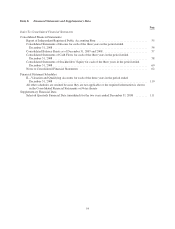Yahoo 2008 Annual Report Download - page 56
Download and view the complete annual report
Please find page 56 of the 2008 Yahoo annual report below. You can navigate through the pages in the report by either clicking on the pages listed below, or by using the keyword search tool below to find specific information within the annual report.flows of each reporting unit discounted by an estimated weighted-average cost of capital, reflecting the overall
level of inherent risk of a reporting unit and the rate of return an outside investor would expect to earn.
Determining the fair value of a reporting unit is judgmental in nature and requires the use of significant estimates
and assumptions, including selection of market comparables, estimated future cash flows, and discount rates.
These components are discussed below:
•Market comparables
We select comparable companies in the specific regions in which our reporting units operate based on
similarity of type of business, primarily those involved in online advertising, and relative size of those
companies compared to our reporting units. Trailing and forward revenue and earnings multiples derived from
these comparable companies are applied to financial metrics of each reporting unit to determine their estimated
fair values.
•Estimated future cash flows
We base cash flow projections for each reporting unit using a five-year forecast of free cash flows and a
terminal value based on the Perpetuity Growth Model. The five-year forecast and related assumptions were
derived from the most recent annual financial forecast for which the planning process commenced in our
fourth quarter. Key assumptions in estimating future cash flows include, among other items, revenue and
operating expense growth rates, terminal value growth rate, and capital expenditure and working capital levels.
Significant management judgment is involved in determining these assumptions.
•Discount rates
We employ a Weighted Average Cost of Capital (“WACC”) approach to determine the discount rates used in our
cash flow projections. The determination of the discount rates for each reporting unit includes factors such as the
risk-free rate of return and the return an outside investor would expect to earn based on the overall level of
inherent risk. The determination of expected returns includes consideration of the beta (a measure of risk) of
traded securities of comparable companies. The discount rates used in this year’s goodwill impairment test were
higher than the prior year to take into account the increased risk of achieving forecasts given the prevailing
macroeconomic and capital market conditions. A two percent increase or decrease in the discount rates in each of
the reporting units would not affect the outcomes of the first step of the goodwill impairment test.
The sum of the fair values of our reporting units is reconciled to our market capitalization adjusted for an
estimated control premium.
We conducted our annual goodwill impairment test as of October 31, 2008 and determined that the fair values of
our reporting units, with the exception of our European reporting unit, exceeded their carrying values by a
significant margin and therefore goodwill in those reporting units was not impaired. We concluded that the
carrying value of our European reporting unit exceeded its fair value and recorded a goodwill impairment charge
of approximately $488 million. See Note 5—“Goodwill” in the Notes to the consolidated financial statements for
additional information.
Significant changes in these estimates and assumptions could materially affect the determination of fair value for
each reporting unit which could trigger future impairment.
Intangible Assets. We amortize intangible assets over their estimated useful lives. Identifiable amortizable
intangible assets are reviewed for impairment whenever events or changes in circumstances indicate that the
carrying value may not be recoverable. Determination of recoverability is based on the lowest level of
identifiable estimated undiscounted future cash flows resulting from use of the asset and its eventual disposition.
Measurement of any impairment loss is based on the excess of the carrying value of the asset over its fair value.
Fair value is determined based on the lowest level of identifiable estimated future cash flows using discount rates
50
























